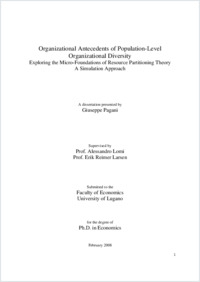Organizational antecedents of population-level organizational diversity : Exploring the micro-foundations of resource partitioning theory : a simulation approach
- Pagani, Giuseppe
- Lomi, Alessandro (Degree supervisor)
- Larsen, Erik Raimer (Degree committee member)
-
25.02.2008
167 p
Thèse de doctorat: Università della Svizzera italiana, 2008 (jury note: cum laude)
English
"Why are there so many kinds of organizations?" (Hannan and Freeman, 1977: 936). As Astley (1985) suggests, "[t]his question focuses inquiry on organizational diversity, the differentiation of organizations into varying population types" (p. 224). Out of the different literature streams, which have addressed the topic of organizational diversity, an effective explanation of the dynamics related to this organizational phenomenon has been provided by Resource Partitioning theory (Carroll, 1985), which has attempted to explain the coexistence of patterns of concentration and specialization within the same industrial setting. Despite the extensive empirical evidence supporting Resource Partitioning theory (see Carroll, Dobrev and Swaminathan, 2002 for a review), an effective and thorough explanation and specification of the causal mechanisms underlying the operation of this industrial segregating process has not yet been effectively advanced. (Carroll and Hannan, 2000; Carroll, et al., 2002). This theory leaves apart many important questions about the emergence, the evolution and the persistence of instances of organizational diversity in given industries. In general, the theory does not specify what a generalist and a specialist organization are. To answer this question, this dissertation aims at complementing industry-level explanations of organizational diversity put forward by resource partitioning theory with an analysis of the internal processes featuring generalist and specialist firms' practices, within the industrial setting of Professional Service Firms (PSFs). This particular context was chosen because PSFs frequently operate in a competitive environment in which "[t]he large, multinational accounting firms coexist with very small, local auditing firms, and both may be highly profitable simultaneously" (Løwendahl, 2005: 127). To attain this task, I rely upon the development of a dynamic simulation model.
- Language
-
- English
- Classification
- Economics
- License
-
License undefined
- Identifiers
-
- RERO DOC 10639
- URN urn:nbn:ch:rero-006-108182
- ARK ark:/12658/srd1318171
- Persistent URL
- https://n2t.net/ark:/12658/srd1318171
Statistics
Document views: 320
File downloads:
- Texte intégral: 210
